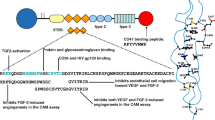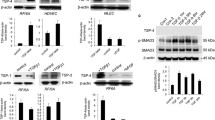Abstract
It is widely established that angiogenesis is required during tumor progression. Emerging data, suggests that estrogens can mediate endothelial proliferation and differentiation. We investigated the role of estrogens in the formation and stabilization of capillary-like structures, and identified 17β-estradiol-driven pathways involved in vessel assembly. We show that estrogens induce MCF7 breast cancer cells to secrete TGFβ1. In addition, TGFβ cross talks with EGFR signaling pathway with concomitant up-regulation of EGFR ligand, TGFα, promoting cord-like formations in HUVEC cultures. The action of 17β-estradiol was not restricted to endothelium, since 17β-estradiol also stimulated recovery and migration of a smooth muscle cell line (FLTR) to injured areas again by the cross talk between these two signaling pathways. Finally, given the relevant role of 17β-estradiol in vessel stabilization, co-cultures of HUVEC and FLTR cells were established in the presence of 17β-estradiol or TGFβ1. By blocking TGFβ or EGFR signaling, we demonstrate that 17β-estradiol promoted vessel stabilization through the interplay of TGFβ1 and EGFR signaling transduction pathways. Our data suggest that estrogen mediates endothelial cell stabilization and vessel assembly. These vessel protective effects involve TGFβ1 and EGFR signaling transduction pathways.
Similar content being viewed by others
References
Marinho A, Soares R, Ferro J et al. Angiogenesis in breast cancer is related to age but not to other prognostic parameters. Pathol Res Pract 1997; 193: 267–73.
Carmeliet P, Jain R. Angiogenesis in cancer and other diseases. Nature 2000; 407: 249–57.
Mendelsohn ME, Karas RH. Mechanisms of disease: The protective effects of estrogen on the cardiovascular system. N Engl J Med 1999; 340: 1801–11.
Hyder S, Nawaz Z, Chiappetta C, Stancel G. Identification of functional estrogen response elements in the gene coding for the potent vascular endothelial growth factor. Cancer Res 2000; 60: 3183–90.
Morales D, McGowan K, Grant D et al. Estrogen promotes angiogenic activity in human umbilical vein endothelial cells in vitro and in a murine model. Circulation 1995; 91: 755–63.
Simoncini T, Maffei S, Basta G et al. Estrogens and glucocorticoids inhibit endothelial vascular cell adhesion molecule-1 transcription by different transcriptional mechanisms. Circ Res 2000; 87: 19–25.
Tamura M, Sebastian S, Gurates B et al. Vascular endothelial growth factor up-regulates cyclo-oxygenase-2 expression in human endothelial cells. J Clin Endocrinol Metab 2002; 87: 3504–7.
Banerjee S, Sarkar D, Weston A et al. Over expression of vascular endothelial growth factor and its receptor during the development of estrogen-induced rat pituitary tumors may mediate estrogen-initiated tumor angiogenesis. Carcinogenesis 1997; 18: 1155–61.
Soares R, Reis-Filho J, Gärtner F, Schmitt FC. VEGF, TGFα and estrogen receptors: Possible cross-talks and interactions. Am J Pathol 2002; 160: 381–3.
Gille J, Swerlick RA, Caughman SW. Transforming growth factoralpha-induced transcriptional activation of the vascular permeability factor (VPF/VEGF) gene requires AP-2–dependent DNA binding and transactivation. EMBO J 1997; 16: 750–9.
Schmitt FC, Soares R. Hormonal control of angiogenesis in breast cancer: TGFα, a missed link? Breast 1999; 8: 154.
Snedeker SM, Diaugustine RP. Hormonal and environmental factors affecting cell proliferation and neoplasia in the mammary gland. Prog Clin Biol Res 1996; 394: 211–53.
Xie B, Tsao S, Wong YC. Sex hormone-induced mammary carcinogenesis in female Noble rats: Expression of TGFβ1 and its receptors, TGFα, and EGF-R in mammary carcinogenesis. Br Cancer Res Treat 2000; 58: 227–39.
Schmitt FC, Soares R. TGFα and angiogenesis. Am J Surg Pathol 1999; 23: 358–9.
Soares R, Botelho M, Silva C et al. Expression of TGFα and EGFR in breast cancer and its relation to angiogenesis. Breast J 2000; 6: 171–7.
Viñals F, Pouyssegur J. Transforming growth factor β1 (TGFβ1) promotes endothelial cell survival during in vitro angiogenesis via an autocrine mechanism implicating TGF-alpha signaling. Mol Cell Biol 2000; 21: 7218–30.
Soares R, Guo S, Russo J, Schmitt FC. Role of the estrogen antagonist ICI 182,780 in vessel assembly and apoptosis of endothelial cells. Ultrastruct Pathol 2003; 27: 33–9.
Darland D, D'Amore P. TGFβ is required for the formation of capillary-like structures in three-dimensional cocultures of 10T1/2 and endothelial cells. Angiogenesis 2001; 4: 11–20.
Patriotis PC, Querec TD, Gruver B et al. ArrayExplorer, a program in visual basic for robust and accurate filter cDNA array analysis. Biotechniques 2001; 31: 862–72.
Kubota Y, Kleinman HK, Martin GR, Lawley TJ. Role of laminin and basement membrane in the morphological differentiation of the human endothelial cells into capillary-like structures. J Cell Biol 1998; 107: 1589–98.
Derynck R, Akhurst R, Balmain A. TGFα signaling in tumor suppression and cancer progression. Nature Genet 2001; 29: 117–29.
Sandberg T, Casslén B, Gustavsson B, Benraad T. Human endothelial cell migration is stimulated by urokinase plasminogen activator: Plasminogen activator inhibitor 1 complex released from endometrial stromal cells stimulated with transforming growth factor β1; possible mechanism for paracrine stimulation of endometrial angiogenesis. Biol Reproduct 1998; 59: 759–67.
Wira C, Roche M, Rossol R. Antigen presentation by vaginal cells: Role of TGFβ as a mediator of estradiol inhibition of antigen presentation. Endocrinology 2002; 143: 2872–9.
Heino T, Hentunen T, Vaananen H. Osteocytes inhibit osteoclastic bone resorption through transforming growth factor-beta: Enhancement by estrogen. J Cell Biochem 2002; 85: 185–97.
Tong G, Rajah T, Zang X, Pento J. The effect of antiestrogens on TGF-beta-mediated chemotaxis of human breast cancer cells. Anticancer Res 2002; 22: 103–6.
Walker R. Transforming growth factor-beta and its receptors: Their role in breast cancer. Histopathology 2000; 36: 178–80.
Ravindranath N, Wion D, Brachet P, Djakiew D. Epidermal growth factor modulates the expression of vascular endothelial growth factor in the human prostate. J Androl 2001; 2: 432–43.
Riedel F, Gotte K, Li M et al. EGFR antisense treatment of human NSCLC cell lines down-regulates VEGF expression and endothelial cell migration. Int J Oncol 2002; 21: 11–6.
Lee CS, Koga M, Sutherland RL. Modulation of estrogen receptor and epidermal growth factor receptor mRNAs by phorbol ester in MCF 7 breast cancer cells. Biochem Biophys Res Commun 1998; 162: 415–21.
Muraoka R, Dumont N, Ritter C et al. Blockade of TGF-β inhibits mammary tumor cell viability, migration and metastases. J Clin Invest 2002; 109: 1551–9.
Bucci B, D'Agnano I, Botti C et al. EGF-R expression in ductal breast cancer: Proliferation and prognostic implications. Anticancer Res 1997; 17: 769–74.
Small D, Kovalenko D, Kacer D et al. Soluble Jagged1 represses the function of its transmembrane form to induce the formation of the Src-dependent chord-like phenotype. J Biol Chem 2001; 276: 32022–30.
Watts P, Stables GS, Akhurst RJ, Mackie RM. Localization of transforming growth factor-alpha RNA and protein in the skin of psoriatic patients receiving therapy. Br J Dermatol 1994; 13: 64–71.
McAllister K, Grogg K, Johnson D et al. Endoglin, a TGF-beta binding protein of endothelial cells is the gene for hereditary hemorrhagic telangiectasia type I. Nature Genet 1994; 8: 345–51.
Fujiwara T, Uehara Y. The cytoarchitecture of the wall and the innervation pattern of the microvessels in the rat mammary gland: A scanning electron microscopic observation. Am J Anat 1984; 170: 39–54.
Author information
Authors and Affiliations
Corresponding author
Rights and permissions
About this article
Cite this article
Soares, R., Guo, S., Gärtner, F. et al. 17β-Estradiol-Mediated Vessel Assembly and Stabilization in Tumor Angiogenesis Requires TGFβ and EGFR Crosstalk. Angiogenesis 6, 271–281 (2003). https://doi.org/10.1023/B:AGEN.0000029413.32882.dd
Issue Date:
DOI: https://doi.org/10.1023/B:AGEN.0000029413.32882.dd




